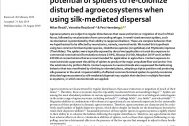Rok
2019Autoři
RNDr. Milan Řezáč, Ph.D.Druhy
Oedothorax apicatus (Blackwall, 1850) ESPhylloneta impressa (L. Koch, 1881) ES
Obsah
Agroecosystems are subject to regular disturbances that cause extinction or migration of much of their fauna, followed by recolonization from surrounding refuges. In small-sized aeronaut spiders, such recolonization is potentiated by their ability to rappel and balloon. These are complex behaviors that we hypothesized to be affected by neurotoxins, namely, neonicotinoids. We tested this hypothesis using two common farmland spider species, Oedothorax apicatus (Linyphiidae) and Phylloneta impressa (Theridiidae). The spiders were topically exposed by dorsal wet application or tarsal dry exposure to commercial neonicotinoid formulations Actara 25 WG, Biscaya 240 OD, Mospilan 20 SP and Confidor 200 OD at concentrations that are recommended for application in agriculture. Contact exposure to neonicotinoids suppressed the ability of spiders to produce the major ampullate fiber and anchor it to the substratum by piriform fibrils. Contact exposure to neonicotinoids also suppressed the ballooning behavior that was manifested by climbing to elevated places, adopting a tiptoe position and producing silk gossamer in the wind. Impaired ability of affected common farmland spiders to quickly recolonize disturbed agroecosystems by silk-mediated dispersal may explain their decline in multiple farmland ecosystems, in which neonicotinoids are applied.



